Monuments of IndiaThere are numerous historical sites and monuments in India, each with a distinct history and cultural value. Apart from displaying works of art, these monuments serve as reminders of India's rich historical and cultural past. From the famous Taj Mahal in Agra to the magnificent Qutub Minar in Delhi, Indian monuments have long attracted tourists from all over the world. These monuments paint a picture of India's rich history and cultural heritage, showcasing the creativity and craftsmanship of builders and talented artisans of yesteryear. We'll examine some of India's most well-known monuments in this article and their complex cultural and historical backgrounds. They are: 1. Taj Mahal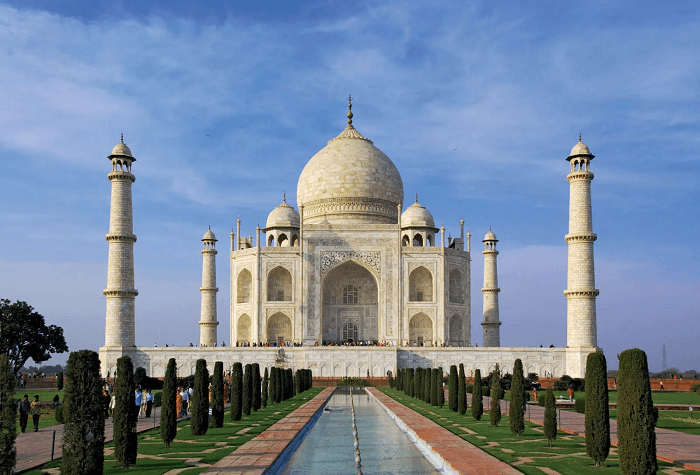
Built by: Shah Jahan Built-in: In the period between 1631-1648 Location: Agra, Uttar Pradesh Timing: 30 minutes before dawn and 30 minutes following sunset (Closed on Friday) Ticket Prices:
OverviewA stunning mausoleum made of white marble, the Taj Mahal is situated in Agra, India. It was commissioned by the Mughal emperor Shah Jahan in honor of his beloved wife, Mumtaz Mahal, who died in childbirth in 1631. The Taj Mahal construction started in 1632 and took around 20 years to complete. The structure, which blends inspirations from Islamic, Persian, and Indian design, is hailed as one of the best examples of Mughal architecture. The Taj Mahal, renowned for its complex carvings, calligraphy, geometric designs, and gorgeous reflection in the nearby pools, is widely regarded as one of the most beautiful structures in the world. Millions of tourists visit the Taj Mahal each year, which is one of India's most visited tourist destinations today and a UNESCO World Heritage site. 2. Hawa Mahal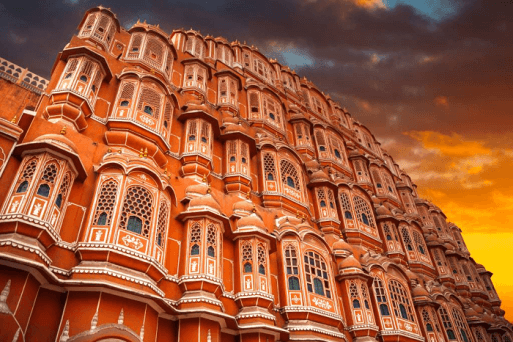
Built by: Maharaja Sawai Pratap Singh Built-in: 1799 Location: Jaipur, Rajasthan Timing: From 9:00 AM to 4:30 PM Ticket Prices: For Indian visitors - INR 50, and for foreign visitors - INR 200 OverviewIn the center of India's Pink City, aka Jaipur, the Hawa Mahal, often called the Palace of the Winds, is stunning. Maharaja Sawai Pratap Singh constructed the palace in 1799 with the intention of giving the royal ladies a view of the busy street life below without being seen themselves. This five-story pink sandstone palace is embellished with 953 tiny windows, or jharokhas, that let cool breezes pass through the structure, keeping it well-ventilated and offering relief from the scorching climate of the city. Beautiful frescoes and motifs that reflect themes from Rajput culture and Hindu mythology are also used to decorate the palace. The Hawa Mahal in Jaipur is now a well-liked tourist destination, giving visitors a look into Rajasthan's fascinating history and culture. 3. Charminar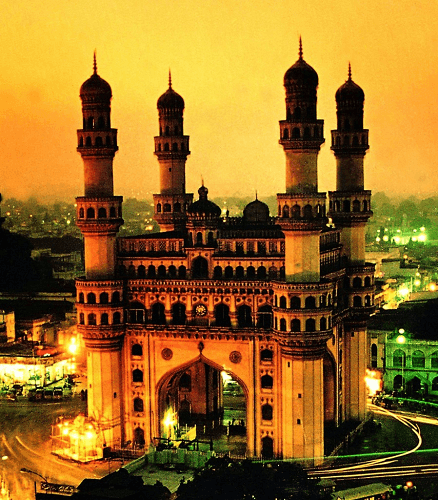
Built by: Sultan Muhammad Quli Qutb Shah Built-in: 1589-1591 Location: Old Hyderabad, Hyderabad, Telangana Timing: From 9:00 AM to 5:30 PM Ticket Prices: For Indian visitors - INR 5, and for foreign visitors - INR 100 OverviewCharminar is a historic structure in Hyderabad. The monument is a stunning example of Indo-Islamic architecture, built in 1591 by Muhammad Quli Qutb Shah, the fifth king of the Qutb Shahi dynasty. The name of the monument is derived from the Urdu words "Char" for four and "minar" for the tower; it alludes to the monument's four elaborate minarets. The 56-meter-tall Charminar is constructed of granite and limestone. It features four arches that point in the four cardinal directions, and the top floor has a lovely balcony with a breathtaking view of the surroundings. The Charminar is not only an impressive architectural feat but also a representation of Hyderabad's vibrant cultural heritage and a well-liked tourist destination. 4. Ajanta Caves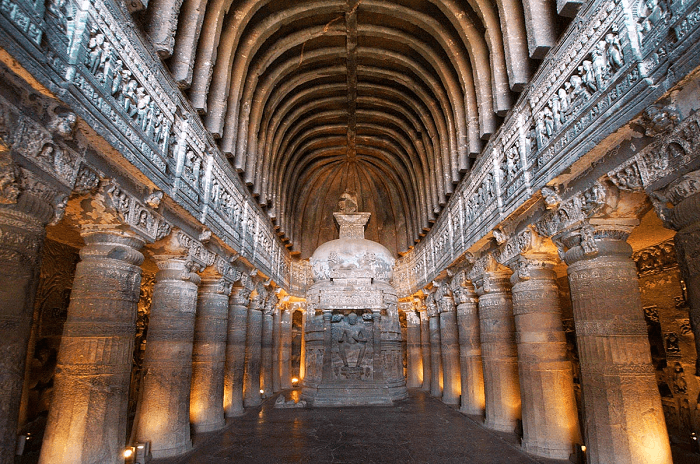
Built by: Hindu and Buddhist Monks Built-in: 2nd century B.C.E. to 650 C.E Location: Aurangabad- 431117, Maharashtra Timing: From 9:00 AM to 5:30 PM (Closed on Monday) Ticket Prices: For Indian Visitors: INR 10 For Foreign Visitors: $5 No Entry fees for those under 15 Extra charges for the camera: INR 5 OverviewThe Ajanta and Ellora Caves are a series of rock-cut cave temples in the Aurangabad district of Maharashtra, India. The caverns have been listed as a UNESCO World Heritage site because they are considered some of the most outstanding examples of ancient Indian architecture and art. The 29 rock-cut caves that make up the 2nd century BCE Ajanta Caves are decorated with exquisite paintings and sculptures that represent scenes from the Buddha's life and other prehistoric Indian customs. The Ellora Caves, in contrast, is a collection of 34 rock-cut temples that exhibit the development of Indian art and architecture over time. They were created between the 6th and 10th centuries CE. The Ajanta and Ellora Caves are examples of the amazing craftsmanship and ability of the early Indian artisans, and they continue to be well-liked tourist and research sites. 5. Vijay Stambh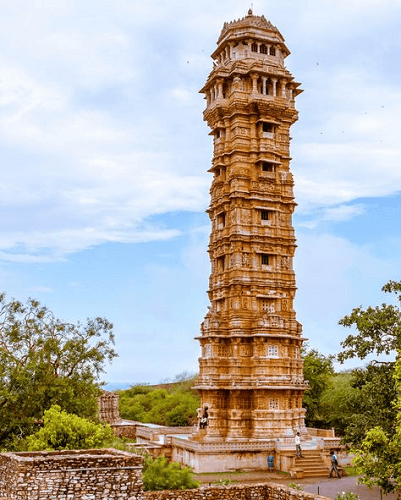
Built by: Rana Kumbha Built-in: Between 1458 and 1488 Location: Chittorgarh, Rajasthan Timing: From 8:00 AM to 6:00 PM Ticket Prices: Free to All OverviewVijay Stambh, also known as the Tower of Victory, is a historical monument in Chittorgarh, Rajasthan, India. Rana Kumbha, the ruler of Mewar, built the tower in 1440 to mark his victory over Mahmud Khilji, the Sultan of Malwa. The structure, which stands 37 meters tall and has nine floors, is a stunning example of Rajput architecture. The tower is decorated with exquisite carvings, sculptures, and inscriptions that show the Rajput rulers' majesty and bravery and their victories over their adversaries. The spiral staircase of the tower offers a wonderful view of the surroundings while climbing to the top. The Vijay Stambh is an outstanding piece of architecture representing the courage and fortitude of Rajput warriors and is a well-liked tourist destination in Rajasthan. 6. Golden Temple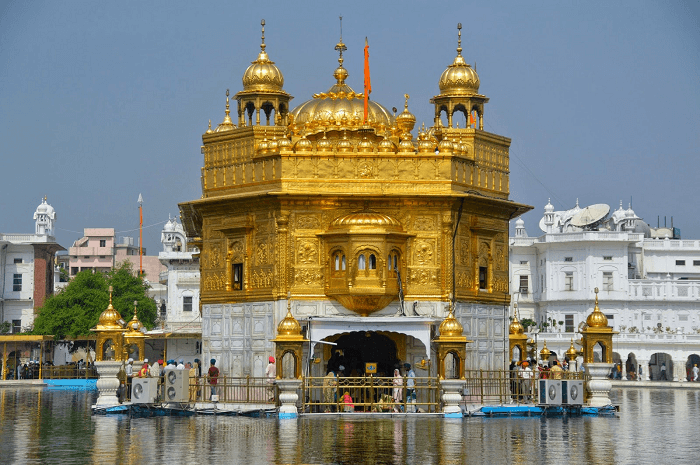
Built by: The fifth Sikh Guru, Guru Arjan Dev Ji Built-in: From 1577 to 1604 Location: Amritsar, Punjab Timing: 4:00 AM to 11:00 PM Ticket Price: Free OverviewThe Golden Temple, often referred to as Sri Harmandir Sahib, is a famous Sikh temple that is situated in Amritsar, Punjab, India. The temple receives millions of pilgrims each year and is regarded as the holiest place in the Sikh religion. The temple is composed of marble, gold leaf, and precious stones, and its architecture is a fusion of Islamic and Hindu forms. An artificial lake called the Amrit Sarovar surrounds the temple and is said to have therapeutic properties. The temple compound also has a langar, a communal kitchen where anyone visiting, regardless of religion or background, can have free food. 7. India Gate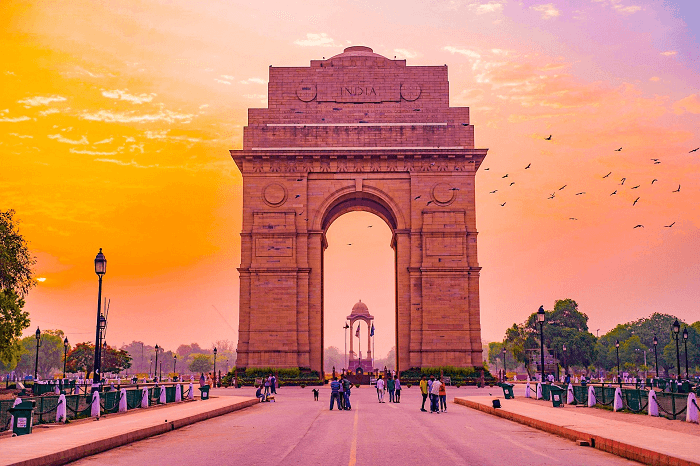
Built by: Sir Edwin Lutyens Built-in: From 1921 to 1931 Location: New Delhi Timing: There are no set hours for when the India Gate is open or closed. The best time to visit this monument is during the early morning or late evening when the weather is pleasant, and the monument is illuminated, providing a spectacular view. Ticket Price: Free OverviewThe All India War Memorial, also known as the India Gate, is located in New Delhi along the Rajpath. Often compared to the French Arch de Triomphe, Mumbai's Gateway of India, and Rome's Arch of Constantine, India Gate's enormous structure is breathtaking. This historic structure, which stands 42 meters tall and is the greatest war memorial in the country, was designed by Sir Edwin Lutyens. India Gate is also well renowned for hosting the Republic Day Parade every year. The memorial, which honors the 82,000 Indian and British soldiers killed in World War I and the Third Anglo-Afghan War, bears the names of around 13,300 service members. 8. Red Fort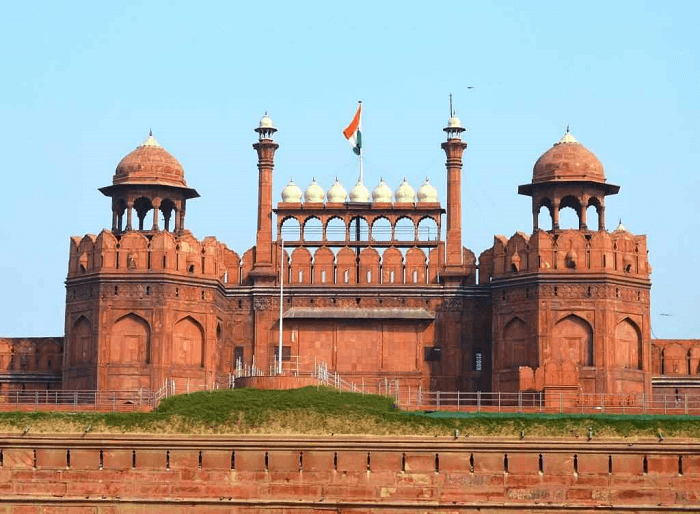
Built by: The Mughal Emperor Shah Jahan Built-in: Between 13 May 1638 to 6 April 1648 Location: Old Delhi, now called Delhi/ New Delhi Timing: 9:30 AM to 4:30 PM (Monday Holiday) Ticket Price: For Indian Visitors - INR 35, and for foreign visitors - INR 500. An extra INR 25 is charged for video camera recording. OverviewThe Red Fort, also known as Lal Qila, is a historical fort in the heart of Delhi, India. The fort was constructed by the Mughal Emperor Shah Jahan in the seventeenth century, and it housed the Mughal Emperor for about two centuries. The red sandstone fort is renowned for its stunning architecture, elaborate carvings, and lovely gardens. It is one of India's most significant historical monuments and a UNESCO World Heritage Site. The Red Fort is a well-liked tourist destination nowadays and is renowned for its sound and light presentations that describe the fort's history and importance in Indian history. At the moment, this monument is home to a number of museums where rare artifacts are on show. The Indian Prime Minister hoists the flag at this memorial every year on Independence Day. 9. Akshardham Temple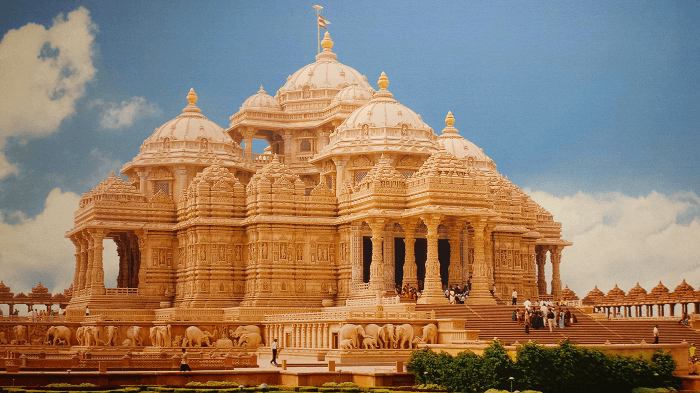
Built by: BAPS (Bochasanwasi Shri Akshar Purushottam Swaminarayan Sanstha) Built-in: 2005 Location: New Delhi, Delhi Timing: 9:30 AM to 8:00 PM (Monday Holiday) Ticket Price: Free to Enter Exhibition FeeFor Adults (12 years and above):
For Children (4 to 11 years):
OverviewThe Hindu temple complex Akshardham is situated in Delhi, India. One of the most spectacular Hindu temples in the world, the temple was constructed in 2005. Beautiful sculptures, detailed carvings, and gorgeous architecture highlight the best traditional Indian art and craftsmanship in the temple complex. The temple also has displays and other attractions that highlight India's spirituality, tradition, and old culture. They include light and sound shows, boat tours that showcase various cultures, and the "Sahajanand Darshan", an interactive experience that highlights the diversity and rich history of India. Delhi's Akshardham is a well-known tourist spot that draws tourists from all over the world. 10. Amar Jawan Jyoti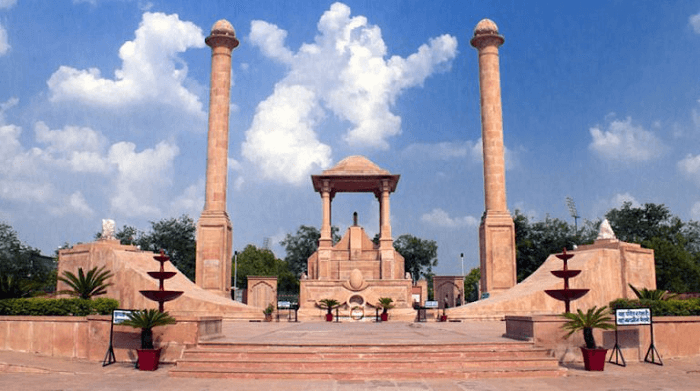
Built by: Indian Army's Corps of Engineers Built-in: 1971 Location: Jaipur, Rajasthan Timing: 7:30 AM to 9:00 PM Ticket Price: Free to all OverviewAt Jan Path on the Jaipur Nagar Nigam road in Jaipur, Rajasthan, you can see the Amar Jawan Jyoti monument. It is famed for its everlasting flames and was built to honor the soldiers and martyrs from Jaipur who served India throughout the war. The monument, which is mostly formed of pink sandstone with a black marble pedestal, was built as a tribute to the brave soldiers who fought in the 1971 Indo-Pakistan War. Torches light up the area at its four corners, and there is a garden around it. These perpetual flames stand in for the enduring spirit of the heroic troops, who are always remembered for their bravery and sacrifice. 11. Amaravati Stupa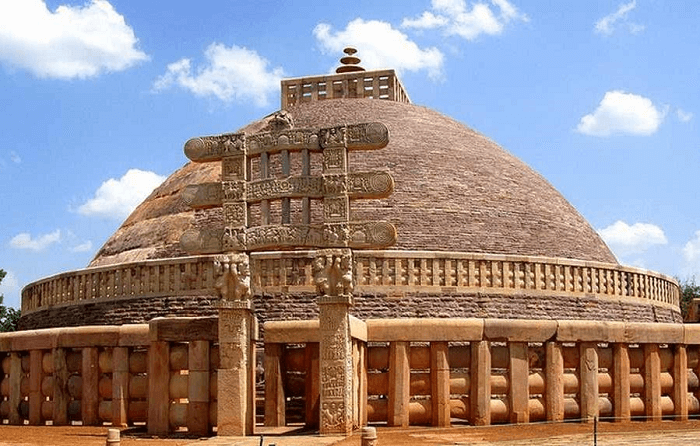
Built by: The Satavahana Dynasty Built-in: During the 2nd Century BCE Location: Amaravati, Andhra Pradesh Timing: From 8:00 AM to 6:00 PM (Closed on Friday) Ticket Price: For Indian Visitors - INR 20, and for foreign visitors - INR 250 OverviewOne of the largest stupas in India and one of the most popular tourist destinations in Amaravati is the Maha Chaitya, also known as Deepaladinne or the Great Stupa of Amaravati. The Amaravati Stupa is an ancient Buddhist monument in Amaravati, Andhra Pradesh, India. The memorial is currently under the protection of the Archaeological Survey of India. The site also features an archaeological museum constructed between the third century BCE and 250 CE in addition to the stupa. Lord Buddha in human form is seated on an elephant on the circular altar of the brick building known as Amaravati Stupa. It was made by a representative of Emperor Ashoka. 12. Iron Pillar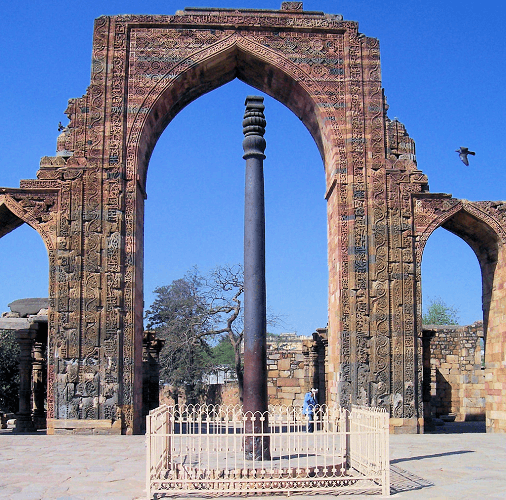
Built by: Chandragupta II Built-in: During 375 - 415 AD Location: Mehrauli, New Delhi Timing: From 10:00 AM to 5:00 PM Ticket Price: For Indian Visitor - INR 50, and for foreign visitors - INR 500 OverviewOne of the numerous enigmatic wonders to be found in Delhi, the Indian capital, is called the Iron Pillar. The Iron Pillar has been acclaimed as one of the greatest metallurgical wonders of all time since it has remained rust-free for thousands of years. The pillar has weathered more than 1600 years of deterioration while remaining sturdy and corrosion-resistant. It is constructed of 98% wrought iron. The pillar is composed of wrought iron and stands around 23 feet (7 meters) tall. The Iron Pillar is considered an engineering marvel of ancient India and a testament to the advanced metallurgical skills of its people. It continues to be a popular tourist attraction in Delhi, drawing visitors from all over the world. 13. Gol Gumbaz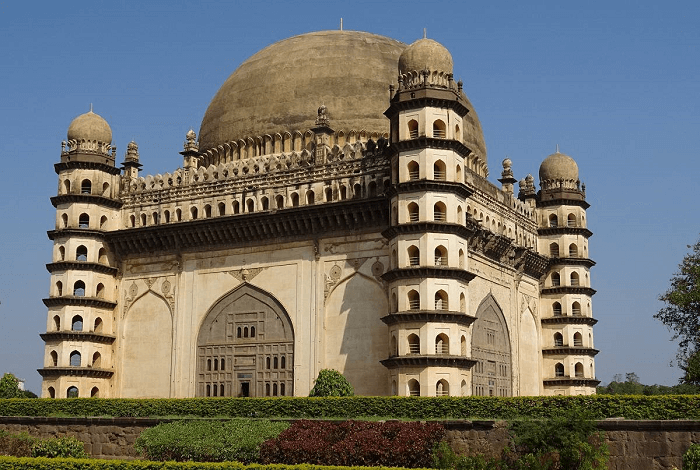
Built by: Yakut of Dabul Built-in: During the 17th century Location: Bijapur, Karnataka Timing: 10:00 AM to 5:00 PM Ticket Price: For Indian visitors - INR 10, and for foreign visitors - INR 100 Best Time to Visit: The months from October to February can be the best to visit Gol Gumbaz due to the pleasant weather. OverviewA mausoleum called Gol Gumbaz can be seen in Bijapur, Karnataka, India. It was built in the 17th century by the Adil Shahi dynasty, and now it is recognized for its second-largest dome in the world and exquisite Indo-Islamic architecture. The mausoleum houses Muhammad Adil Shah's tomb, along with those of his wives and daughters. The dome's facade is embellished with minarets and balconies, and its inside is ornamented with elaborate carvings and paintings. Visitors can ascend to the dome's summit and take in expansive views of the surroundings. It is a noteworthy historical landmark that draws visitors from all over the world. 14. Jama Masjid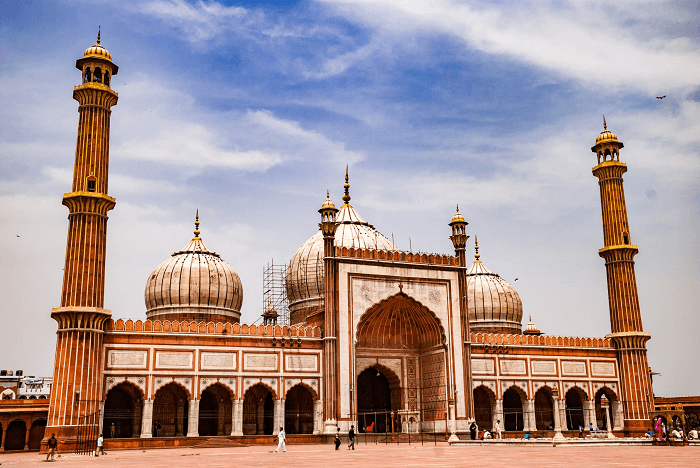
Built by: Shah Jahan Built-in: Between 1644 and 1656 Location: Old Delhi, India Timing: From 7:00 AM - 12:00 PM and 1:30 PM - 6:30 PM Ticket Price: Entry is free except for photography costing INR 200, and the tower costing INR 100 OverviewIt is one of India's biggest mosques, with enough space for up to 25,000 worshippers. The mosque is recognized for its stunning architecture, which includes two 40-meter-tall minarets, three marble domes, and a sizable courtyard that can hold many people. The mosque's elaborate prayer hall is open for visitors to explore and is embellished with calligraphy and beautiful patterns. The mosque is still a significant religious and cultural monument in Delhi and a well-liked travel destination. The Eid celebration is when Jama Masjid is the most alive and attractive. During the month of Ramadan, the commotion on the streets of the Jama Mosque and Chandni Chowk intensifies ten-fold. Everyone receives iftar meals at the mosque, and many street food vendors set up shop accordingly. One can also take advantage of the delicious kebabs sold on the streets. 15. Mysore Palace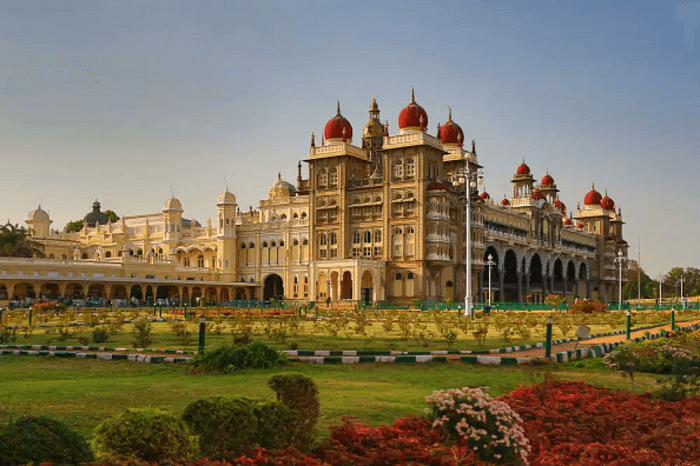
Built by: Krishnaraja Wadiyar IV Built-in: Between 1897 and 1912 Location: Mysore, Karnataka Timing: From 10:00 AM to 5:30 PM Ticket Price:
OverviewThe Mysore Palace, also known as Amba Vilas Palace, is a historical palace located in Mysore, Karnataka, India. Built between 1897 and 1912 by British architect Henry Irwin, it is a blend of various architectural styles, including Indo-Saracenic, Neo-Classical, and Gothic. The palace is renowned for its elaborate decorations, stained glass windows, and detailed carvings. It has several courtyards, gardens, and rooms showcasing the opulence of the Wadiyar dynasty. One of the most preferred tourist destinations in India, this palace is accessible to the general public. On special occasions like Dussehra, thousands of lights are also used to illuminate it. 16. Humayun Tomb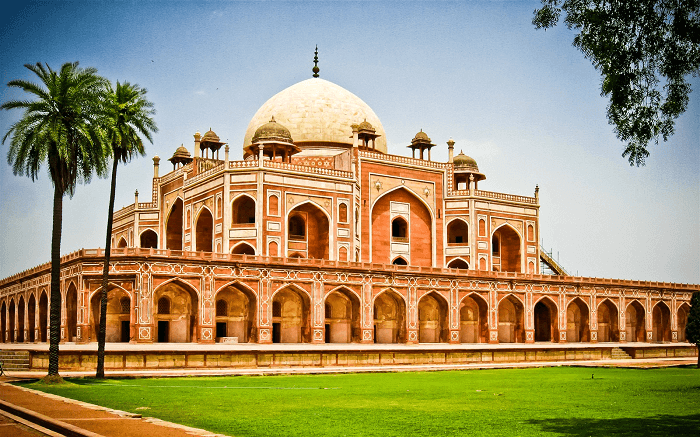
Built by: Humayun's Wife, Bega Begum Built-in: 1569 Location: Nizamuddin, New Delhi Timing: From 10:00 AM to 6:00 PM Ticket Price:
OverviewThe Mughal Empress Bega Begum erected the beautiful Humayun Tomb in Delhi, India, in the middle of the 16th century as a memorial to her late husband, Emperor Humayun. With characteristics from both India and Persia, it is regarded as a masterpiece of Mughal architecture. Four paths and water channels converge in the middle of the char bagh-style garden that encircles the tomb. The tomb's primary structure is composed of red sandstone, with white marble and elaborate decorative embellishments added later. As a UNESCO World Heritage Site, the Humayun Tomb is a well-liked tourist destination and an important cultural icon in Delhi. 17. The Mehrangarh Fort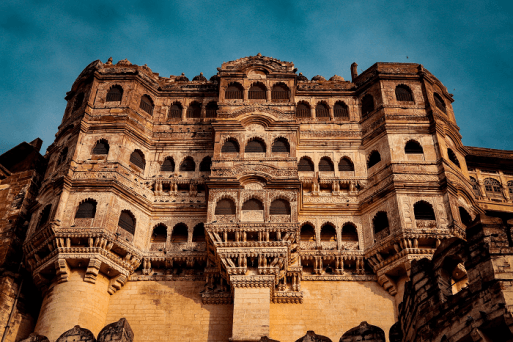
Built by: Rao Jodha Built-in: Mid of 15th Century Location: Jodhpur, Rajasthan Timing: From 9:00 AM to 5:00 PM Ticket Price:
OverviewIn the mid-15th century, Rao Jodha, the founder of Jodhpur, built the majestic Mehrangarh Fort in the city of Jodhpur, Rajasthan, India. The fort overlooks the city and the surrounding desert from a rocky height where it is situated. The fort's stunning architecture comprises several palaces, courtyards, and temples that are all decorated with complex carvings, wonderful artwork, and lovely designs. An extensive collection of antiquities, including weaponry, paintings, textiles, and musical instruments, are shown in the fort's museum, adding to its importance as a monument. Rajasthan's Mehrangarh Fort, renowned for its breathtaking beauty and historical significance, is a well-liked tourist destination and an important cultural relic. 18. Amber Fort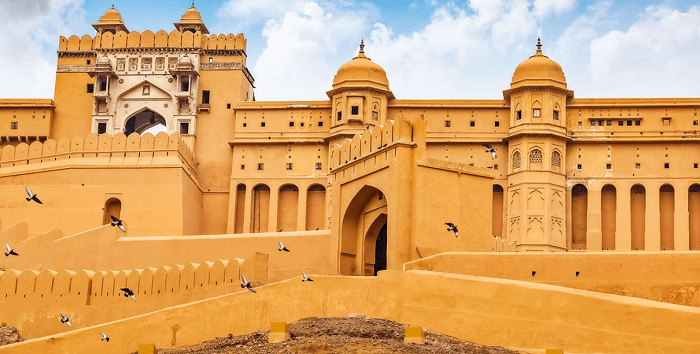
Built by: Raja Man Singh I Built-in: Late 16th Century (1569 began) Location: Jaipur, Rajasthan Ticket Price: For Indian visitors - INR 100, and for Foreign visitors - INR 500 In addition to the entry fee, there may be additional fees for audio guides, camera fees, and entry to certain sections of the fort, such as the Sheesh Mahal (Palace of Mirrors). Timing: From 9:00 AM to 6:00 PM The best time to visit the Amber Fort in Jaipur, India, is during the winter season, which lasts from October to March. You can also watch The Famous Lightning and Sound Show at certain times, as shown below:
OverviewThe Amber Fort, also known as Amer Fort, is a magnificent fortress located in Jaipur, Rajasthan, India. Built-in the late 16th century by Raja Man Singh I, the fort boasts stunning architecture and intricate artwork and is one of India's most impressive and significant forts. The fort is situated on a hilltop overlooking Maota Lake, and a series of courtyards and ramparts connect its many palaces, temples, and gardens. The Diwan-i-Am (Hall of Public Audience), the Sheesh Mahal (Palace of Mirrors), and the Sukh Niwas (Hall of Pleasure) are just a few of the fort's many sites that tourists can explore. The fort is a well-liked tourist destination in India and provides stunning views of the surrounding countryside as well. In addition, the Sound and Light Show held every evening narrates the fort's history captivatingly, making for an unforgettable experience. 19. Chhatrapati Shivaji Terminus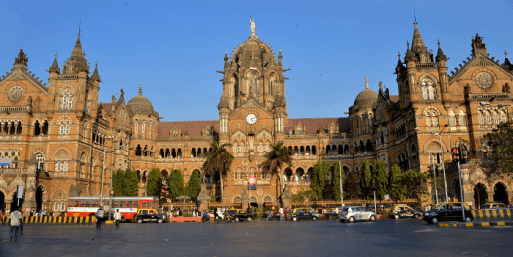
Built by: British architect Frederick William Stevens Built-in: During 1878 - 1887 Location: South Mumbai, Maharashtra Timing: Any Time Ticket Price: Free to all OverviewThe historic railway station Chhatrapati Shivaji Terminus, originally Victoria Terminus, is in Mumbai, India. It was constructed in 1887 under the British Raj in India and was designed in the Victorian Gothic Revival style by British architect Frederick William Stevens. The station is a well-known landmark in Mumbai, distinguished by its abundant construction and recognizable clock tower. One of the busiest railway stops in India, this station now houses the Central Railway's administrative offices. Long-distance and local trains link Mumbai to other regions of the nation. Chhatrapati Shivaji Terminus was recognized for its cultural and architectural significance in 2004 when UNESCO designated it as a World Heritage Site. Today, it continues to be an important transportation hub and a symbol of Mumbai's rich history and cultural heritage. 20. Khajuraho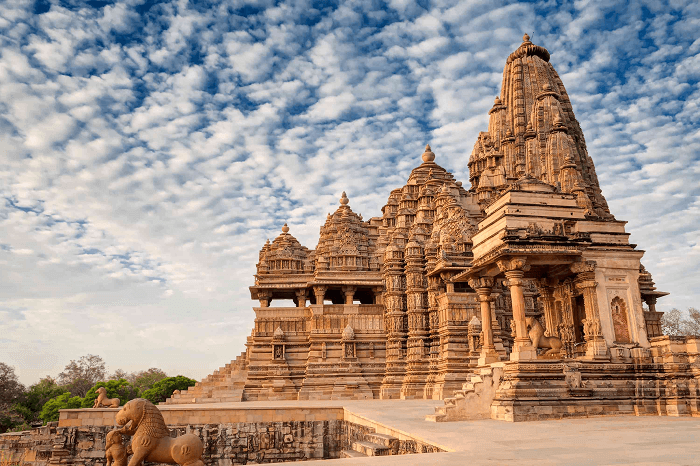
Built by: Chandela Rulers Built-in: Between 950 and 1050 CE Location: Madhya Pradesh, India Timing: From 8:00 AM to 6:00 PM (the best time to visit the temple is between October and March) Ticket Price: Free to all OverviewIt is well-known for the Khajuraho Group of Monuments, a collection of Hindu and Jain temples constructed between 950 and 1050 CE by the Chandela dynasty. The elaborate carvings and sculptures in the temples, which show many deities, heavenly beings, and scenes from daily life, are well-known. The temples of Khajuraho are recognized under UNESCO World Heritage Sites, which attract visitors from all over the world. Khajuraho is well known for its culture, rituals, and temples, particularly the Khajuraho Dance Festival, which is held in February. The town has plenty of hotels and guesthouses for tourists, as well as many shops selling locally made crafts and trinkets. 21. Konark Sun Temple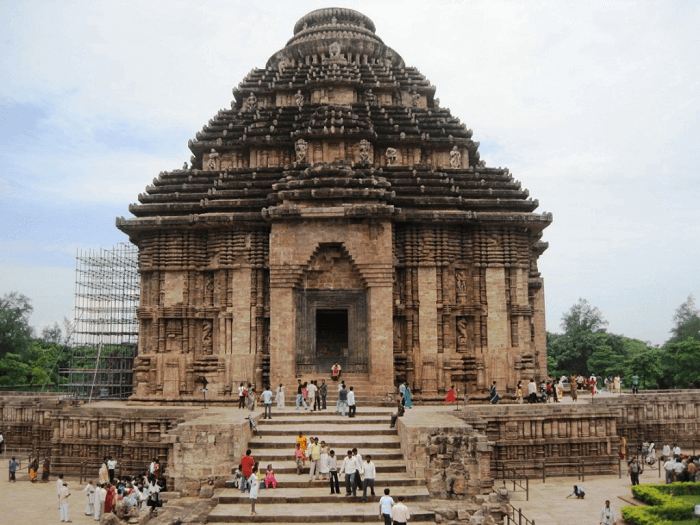
Built by: King Narasimhadeva I Built-in: During the 13th century CE Location: Konark, Odisha Timing: From 6:00 AM to 8:00 PM Ticket Price: For an Indian visitor, the price is INR 30, while the entry fee for a foreign visitor is INR 500 per person. There may be additional charges for photo and video cameras. OverviewThe Konark Sun Temple, a UNESCO World Heritage Site, is located in Konark town in the Indian state of Odisha. It was built in the 13th century by the Eastern Ganga dynasty King Narasimhadeva I. The temple is devoted to the Hindu god Surya and is built like a chariot with 24 wheels, each measuring around 10 feet in diameter. The temple is well-known for both its unique architecture and its exquisite stone carvings, which represent scenes from Hindu mythology. Over time, the temple was partially destroyed, but it has since been repaired, making it one of India's most well-liked tourist attractions. 22. Lotus Temple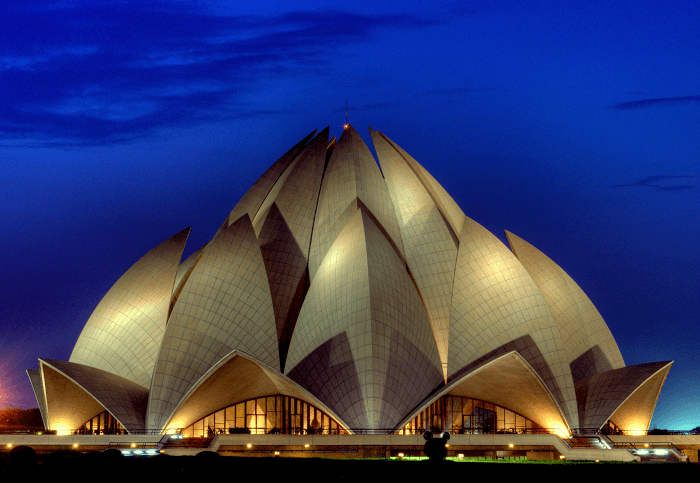
Built by: Iranian architect Fariborz Sahba Built-in: Between 1980 and 1986 Location: Kalkaji, New Delhi Timing: From 9:30 AM to 7:00 PM (Monday Holiday) Ticket Price: Free to all OverviewThe Lotus Temple, commonly referred to as the Bahá' House of Worship, is a well-known building in New Delhi, India. The design was developed by Iranian-Canadian architect Fariborz Sahba and completed in 1986. The temple has 27 white marble "petals" set in three layers around a central hall with space for 2,500 people, giving it the appearance of a lotus flower. It serves as a center for prayer, meditation, and spiritual reflection and is accessible to individuals of all religions. The Lotus Temple has received various honors for its architecture, including the Urban Land Institute's Global Award for Excellence. It ranks among the most popular tourist destinations in India. 23. Victoria Memorial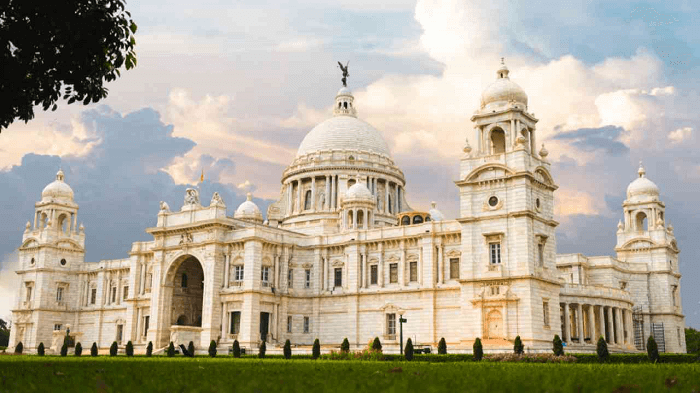
Built by: Sir William Emerson and Vincent Esch Built-in: Between 1906 and 1921 Location: Kolkata, New Delhi Timing: From 10:00 AM to 5:30 PM (Except Mondays) Ticket Price: For Indian visitors - INR 30, and for foreign visitors - INR 500 OverviewIn Kolkata, an Indian state, there is a magnificent marble structure called the Victoria Memorial. Sir William Emerson, a British architect, created the memorial, which was constructed between 1906 and 1921, to honor Queen Victoria's passing in 1901. It is a well-known Indian tourist destination and one of Kolkata's most recognizable monuments. There are magnificent grounds surrounding the structure, and inside it is a museum that houses various artifacts from the time of the British Raj period. The museum contains art, history, and culture galleries, in addition to a sizable collection of books and papers from the British colonial era. India's colonial past is poignantly brought to memory by the Victoria Memorial, which also serves as a symbol of the nation's rich cultural legacy. 24. Nalanda University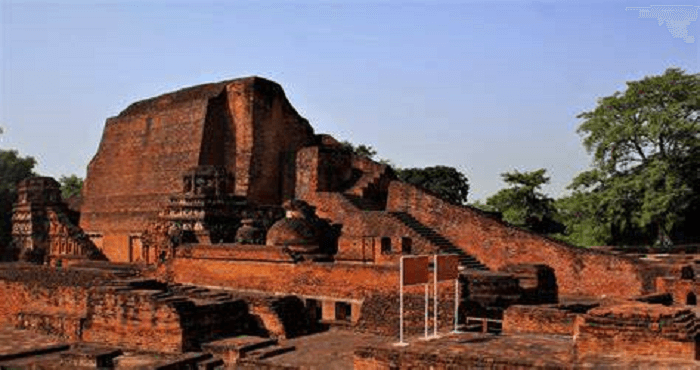
Built by: Kumaragupta I Built-in: Between 415 and 455 CE Location: Nalanda, Bihar Timing: From 09:00 AM to 5:00 PM Ticket Price: For Indian visitors - INR 15, and for foreign visitors - INR 200 OverviewNalanda University was one of the most prominent learning centers in ancient India, located in the present-day Indian state of Bihar. The institution, which was founded in the fifth century CE, was a significant center of Buddhist learning and drew academics and students from all over the world. The university flourished under the patronage of the Gupta and Pala dynasties and was renowned for its scholarship and research in various fields, including mathematics, astronomy, medicine, and Buddhism. Unfortunately, the university was destroyed by invading forces in the 12th century, and it was never rebuilt. To revive the old heritage of learning and research, the Government of India has founded a new Nalanda University nearby. The modern university seeks to promote interdisciplinary research and collaboration among scholars from different parts of the world. 25. Basilica of Bom Jesus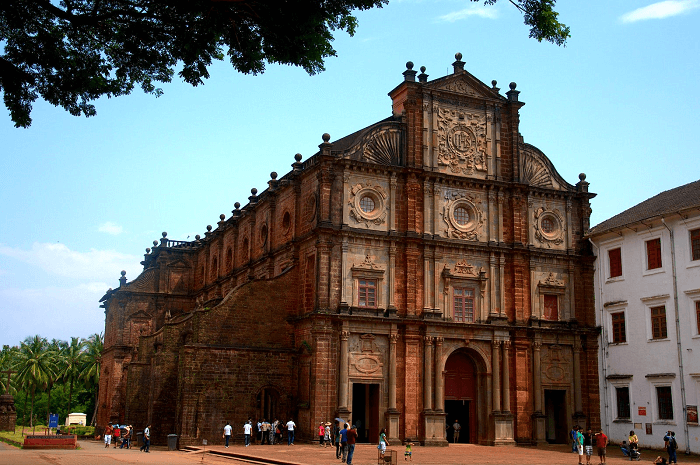
Built by: Jesuits Built-in: Between 1594 and 1624 Location: Old Goa Rd, Bainguinim, Goa Timing: From 09:00 AM to 6:30 PM (Monday - Saturday), and on Sunday, it opens at 10:30 AM. Ticket Price: Free to all OverviewOne of India's oldest and most important churches, the Basilica of Bom Jesus is a historic building that can be found in Old Goa. The church was constructed in the 16th century by the Portuguese, and it is a UNESCO World Heritage Site. The church is well known for its beautiful patterns and elaborate ornaments that are typical of Baroque architecture. It is also well-known for housing St. Francis Xavier's mortal remains, a well-known Christian missionary who made a substantial contribution to the spread of Christianity in India. The basilica is a major pilgrimage site for Christians, and thousands of devotees visit every year to pay homage to the saint. The Basilica of Bom Jesus is an important landmark of India's colonial past and a symbol of the country's rich cultural heritage. 26. Sanchi Stupa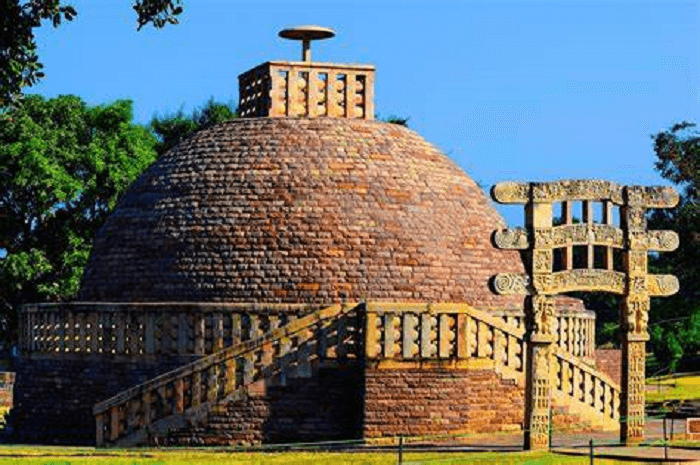
Built by: Emperor Ashoka of the Maurya dynasty Built-in: During the 3rd Century BCE Location: Sanchi town, Raisen district, Madhya Pradesh Timing: From 06:30 AM to 6:30 PM Ticket Price: For Indian visitors - INR 30, and for foreign visitors - INR 500 OverviewA historic Buddhist structure known as the Sanchi Stupa may be seen in the Madhya Pradesh state of India's town of Sanchi. Emperor Ashoka built it in the 3rd century BCE as a tribute to the site where Buddha delivered his first sermon after enlightenment. The original structure of the stupa was expanded and modified over the centuries by different rulers and Buddhist communities. The stupa consists of a dome-shaped structure that houses relics of the Buddha and is surrounded by a circular path called the pradakshina path. The stupa is adorned with four ornate gateways, or toranas, added in the 1st century BCE. A UNESCO World Heritage Site, the Sanchi Stupa is regarded as one of the most significant and well-preserved Buddhist structures in existence. It is a significant Buddhist pilgrimage place that draws tourists from all over the world. 27. Meenakshi Temple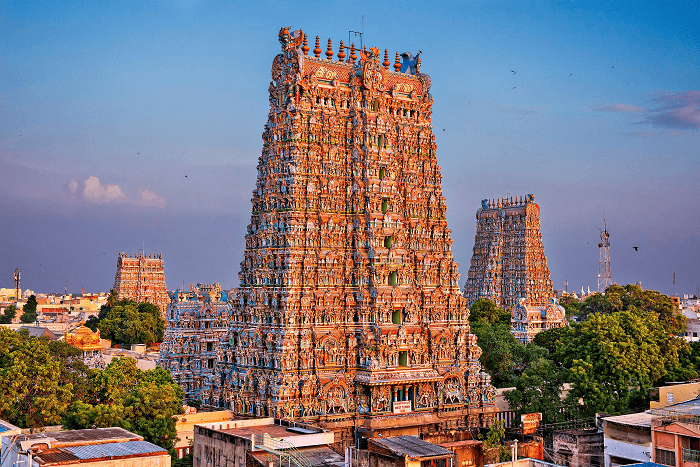
Built by: Kulasekara Pandya Built-in: During the 6th century CE Location: Madurai, Tamil Nadu Timing: From 09:00 AM to 7:00 PM Ticket Price: Free to all OverviewMeenakshi Temple, a well-known Hindu temple honoring Goddess Meenakshi and Lord Sundareswarar, is situated in Madurai, Tamil Nadu, India. The temple was initially constructed in the sixth century CE, but it underwent significant modifications and expansion during the Nayak dynasty in the sixteenth century. The 14-acre temple complex has four main gopuram towers that are individually decorated with beautiful carvings and sculptures. With a height of 52 meters, this tall tower is a well-liked tourist destination. Goddess Meenakshi, the temple's principal deity, is renowned for her ferocious and protective personality, while Lord Sundareswarar is regarded as the pinnacle of the divine male. The temple is a well-known pilgrimage site that draws a large number of visitors and worshippers each year. 28. Kanch Mahal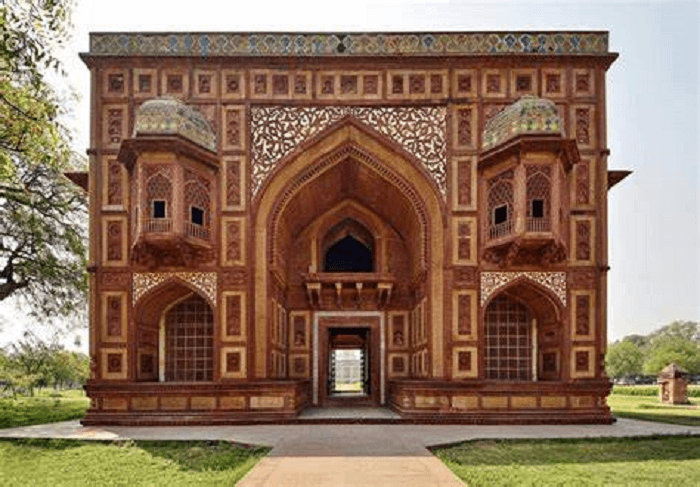
Built by: Mughal Emperor Jahangir Built-in: 1609 Location: Agra, Uttar Pradesh Timing: From 7:00 AM - 6:00 PM Ticket Price:
OverviewThe apparent square shape of the Kanch Mahal covers its intricate architectural design. The Church Missionary Society eventually took over maintenance of the building, which was thereafter given to the Department of Archaeology. The artistically carved red stone used for the mansion's walls has designs of wine vases, arabesques, flowery creepers, and geometric shapes. A carved wood doorway that is oblong in shape leads into the main hall. When you first walk in, the ceiling's reflecting splendor and mosaics of blue, green, and orange glazed tiles catch your attention. It's possible that this is what gave the structure its name. 29. Chini Ka Rauza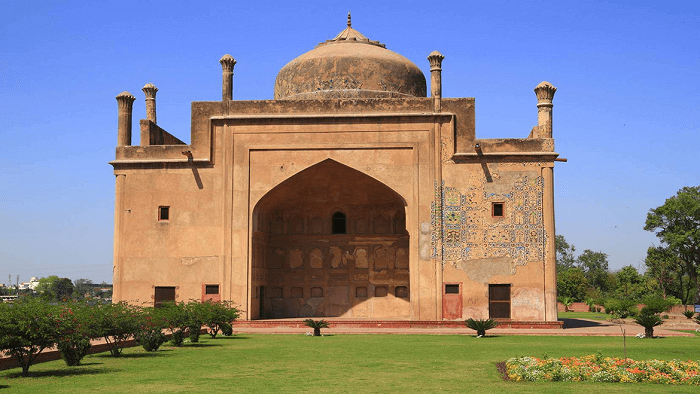
Built by: Allama Afzal Khan Mullah Built-in: Between 1628 and 1639 Location: Agra, Uttar Pradesh Timing: Any time in a day Ticket Price: Free to all OverviewA funerary monument in Agra, India, called Chini ka Rauza, is renowned for its distinctive design and fine tile work. It was built in the 17th century as a tomb for Shah Jahan's Prime Minister, Allama Afzal Khan Mullah, a Persian poet and thinker. The blue and white glazed tile work that spans the majority of the front and interior of the building is the monument's most prominent feature. The Quranic texts and Persian poetry are depicted on the tiles, organized in complex geometric designs. Chini ka Rauza is recognized as a marvel of Mughal architecture and tile artistry despite being a tiny building. 30. Masroor Rock Cut Temple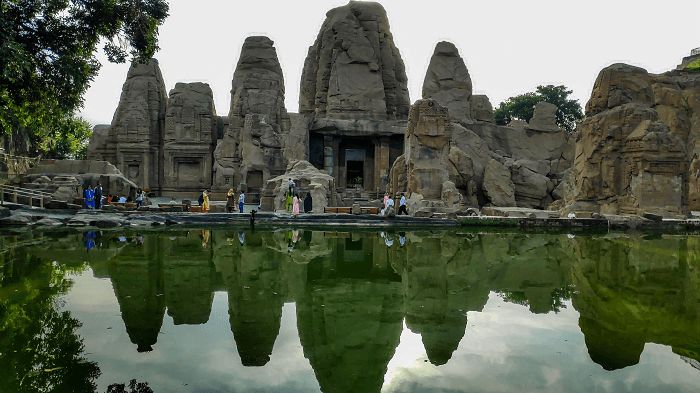
Built by: The Katoch dynasty Built-in: Between the 6 to 18 centuries Location: Kangra district, Himachal Pradesh, India Timing: From 9:00 AM - 5:00 PM Ticket Price: Free to all OverviewA collection of temples called Masroor Rock Cut Temple is situated in Himachal Pradesh's Kangra district. It is a special landmark recognized for its beautiful carvings, rock-cut architecture, and sculptures of Hindu deities, including Shiva, Vishnu, and Durga. The Katoch dynasty is thought to have constructed the temple complex between the eighth and tenth centuries CE. It is regarded as a masterpiece of Indian rock-cut architecture and is made up of 15 temples that were carved out of a single rock formation. A well-liked tourist destination in the area, Masroor Rock Cut Temple is evidence of India's rich cultural past. 31. Safdarjung Tomb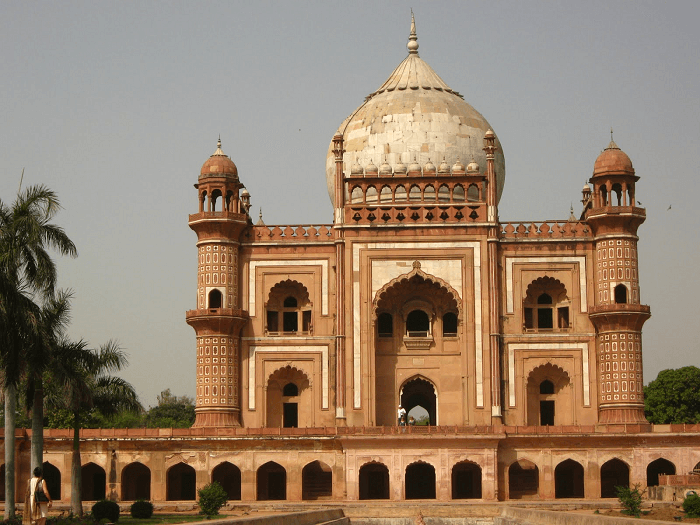
Built by: Ahmad Shah Bahadur, Built-in: 1754 Location: New Delhi Timing: From 9:00 AM - 5:00 PM Ticket Price: Free to all OverviewA historical landmark called Safdarjung Temple may be found in New Delhi, India. It was built in the middle of the 18th century. The temple is a superb example of Mughal architecture and is well known for its exquisite carvings and ornamentation. It boasts a magnificent landscape with fountains, water channels, and a central dome surrounded by four smaller domes. The Persian-style garden contains a wide variety of plants and trees. Safdarjung Temple is a well-liked tourist destination that is also used for festivals and cultural activities. 32. Laxmi Vilas Palace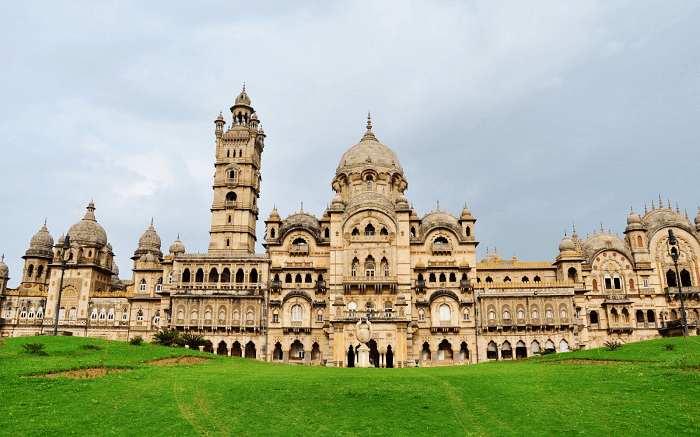
Built by: Maharaja Sayajirao Gaekwad II Built-in: 1890 Location: Vadodara, Gujarat Timing: From 9:30 AM - 5:00 PM. On Mondays and National Holidays, it is closed. Ticket Price: For Indian visitors - INR 150, and for foreign visitors - INR 600. Additional charges for the museum - INR 60 OverviewThe majestic Laxmi Vilas Palace is a palace that can be found in Vadodara, Gujarat, India. The palace, which spans around 700 acres and was built in 1890 by Maharaja Sayajirao Gaekwad III, is one of the biggest private mansions in the world. The palace's elaborate carvings, sculptures, and murals are a fusion of several architectural traditions. It also houses a museum displaying the royal family's paintings, sculptures, and armor collection. The palace's Durbar Hall is a breathtaking space that can accommodate up to 5,000 people and is adorned with Venetian mosaic and Belgian stained glass. The palace's stunning gardens are also a major attraction and contain various species of flora and fauna. It also includes a mini-railway station and a golf course. Anyone interested in India's rich cultural heritage and history must visit Laxmi Vilas Palace. 33. Rani Ki Vav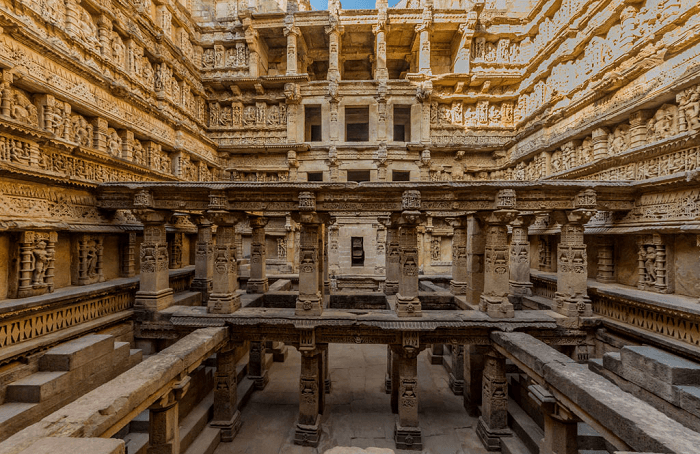
Built by: Queen Udayamati, the wife of King Bhimdev I of the Solanki dynasty Built-in: During the 11th century AD Location: Patan, Gujarat Timing: From 8:00 AM - 6:00 PM Ticket Price: For Indian visitors - INR 15, and for foreign visitors - INR 200 OverviewRani ki Vav, sometimes called the Queen's Stepwell, is situated in the Gujarati town Patan and is located on the banks of the Saraswati River. It is recognized as a UNESCO World Heritage site. The stepwell was constructed by Queen Udayamati, King Bhimdev I's wife, in the 11th century AD as a tribute to the king. With over 800 complex carvings and sculptures representing numerous Hindu gods and goddesses, it is regarded as one of India's most meticulously crafted step wells. The stepwell is renowned for its amazing engineering, which allows it to store water even during dry periods. The seven steps of stairs that lead to the river at Rani ki Vav are a striking example of Maru-Gurjara architecture, and there are also many carvings and sculptures throughout the structure. Anyone with a passion for Indian history, culture, or architecture should make the trip to this place. 34. Golconda Fort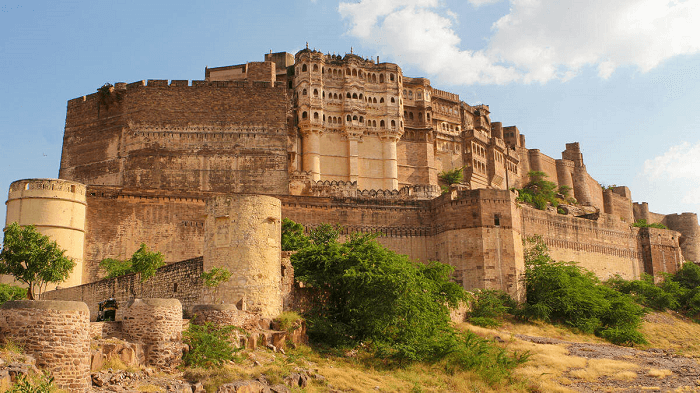
Built by: The Kakatiya Dynasty Built-in: During the 13th century AD Location: Hyderabad, Telangana Timing: From 8:00 AM - 5:30 PM Ticket Price: For Indian visitors - INR 25, and for foreign visitors - INR 300. There is an additional charge of INR 130 for the light and Sound show. OverviewThe Kakatiya dynasty constructed the Golconda Fort in Hyderabad, Telangana, India, in the 13th century, and the Qutb Shahi dynasty extended it in the 16th and 17th centuries. The fort, renowned for its remarkable architecture, engineering, and acoustics, was once a hub of the diamond trade. The fort is home to a number of noteworthy buildings, including the Fateh Darwaza, which serves as the fort's main entrance, and the Taramati Mosque, an old mosque perched atop a hill and renowned for its remarkable acoustics that allow sound to reach about one kilometer away. The fort also contains a number of interesting bastions, gates, and ramparts. For those who are interested in Indian history, architecture, and culture, Golconda Fort is a must-see location. 35. Shaniwar Wada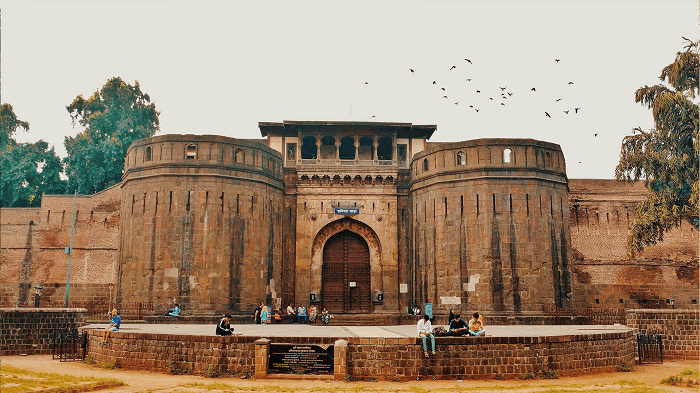
Built by: Bajirao I Built-in: During the 18th century Location: Pune, Maharashtra Timing: From 8:00 AM to 6:30 PM. The light and sound show has daily ticket reservations from 6:30 PM to 8:30 PM. Ticket Price: For Indian visitors - INR 15, and for foreign visitors - INR 200. There is an additional charge of INR 25 for the light and Sound show. OverviewShaniwar Wada is a medieval fortification in the Indian city of Pune. The fort, which Peshwa Baji Rao I built in the 18th century, housed the Peshwa government of the Maratha Empire until a fire destroyed it in 1828. The fort has amazing architecture, exquisite paintings, and carvings that showcase Maratha's construction methods. Numerous gates, courtyards, and gardens in the fort are interesting to explore. A light and sound performance depicting the history of the fort and the Peshwas is also available for visitors. Being regarded as a representation of Maratha tradition and history, Shaniwar Wada is a well-liked tourist attraction. 36. Vivekananda Rock Memorial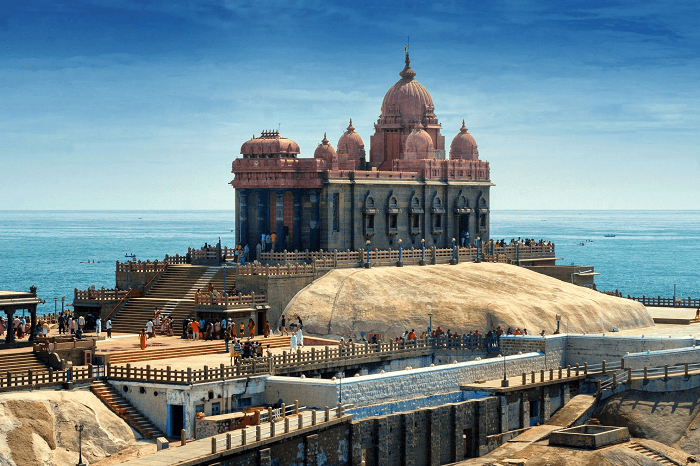
Built by: Vivekananda Rock Memorial Committee Built-in: Between 1964 and 1970 Location: Kanyakumari, Tamil Nadu Ticket Price:For Indian visitors - INR 50, and for foreign visitors - INR 150 For the ferry - INR 34 per person plus INR 20 for memorial Timing:From 7:00 AM to 5:00 PM. Ferry Timing is 8:00 AM to 4:00 PM Best Time to Visit: From October-March (If you want to see the Cape Festival, November is the best month) OverviewIt is referred to as a well-liked tourist attraction in Kanyakumari, Tamil Nadu, India. Swami Vivekananda, a well-known Hindu philosopher, and monk who meditated on the rock for several days in 1892, is remembered by the memorial, which was constructed in his honor in 1970. Visitors must use a ferry to get to the memorial, which is located on a tiny rock island in the middle of the ocean. The Vivekananda Mandapam and the Shripada Mandapam are the two primary buildings in the complex, and they both hold different exhibits about Vivekananda's life and beliefs. The mausoleum is a must-see in Kanyakumari because it provides breathtaking sea vistas. 37. Bara Imambara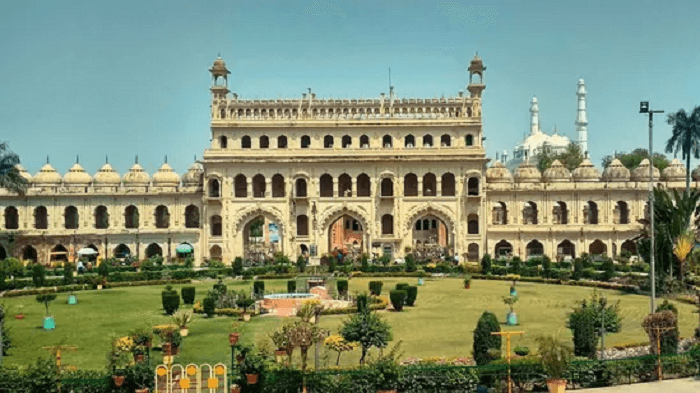
Built by: Nawab Asaf-Ud-Daula Built-in: From 1784 to 1798 Location: Lucknow, Uttar Pradesh Timing: From 6:00 AM to 5:00 PM Ticket Price: For Indian visitors - INR 50, and for foreign visitors - INR 500 OverviewA historical landmark called Bara Imambara can be found in Lucknow, Uttar Pradesh, India. Nawab Asaf-Ud-Daula constructed it in the 18th century, and it is renowned for its distinctive architecture that combines Indo-Islamic and Mughal traditions. The monument's principal hall is one of the largest arched rooms in the world without pillars supporting the ceiling. The monument also has other elements, including the Bhool Bhulaiya, a labyrinth-like network of halls and hallways. Another noteworthy aspect of the complex is the Asfi mosque, which is located on its western side. 38. Jaisalmer Fort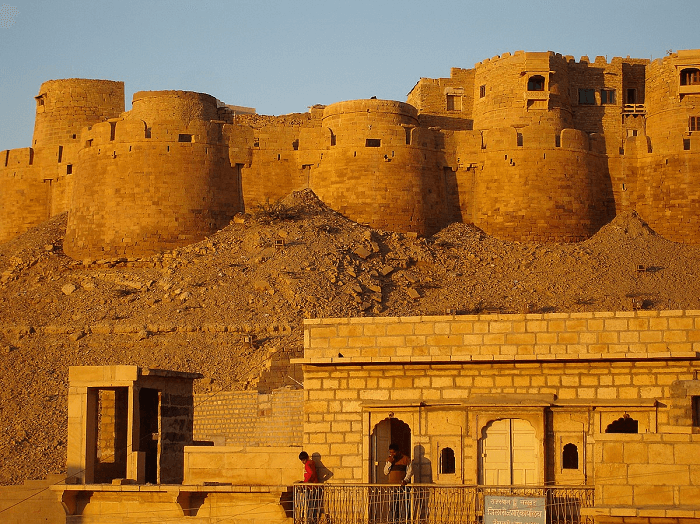
Built by: Rawal Jaisal Built-in: 1156 AD Location: Jaisalmer, Rajasthan Timing: From 9:00 AM to 5:00 PM Ticket Price: For Indian visitors - INR 50, and for foreign visitors - INR 250. There is an additional charge for Video Recording of INR 150. OverviewIn Jaisalmer, a city in Rajasthan, India, there is an ancient fortification called Jaisalmer Fort, sometimes called Sonar Quila. It is one of the biggest forts in the world and is renowned for its gorgeous yellow sandstone construction. Rajput monarch Rawal Jaisal built it in 1156. The fort's palaces, temples, and homes are all constructed of the same yellow sandstone, giving it a distinctive and alluring appearance. Along with these noteworthy elements, the fort has the Raj Mahal, Jain temples, and the Laxminath temple. A flourishing living fort of thousands of inhabitants, including traders, craftsmen, and artisans, the Jaisalmer Fort is one notable historical site. The fort draws tourists from all over the world who come to experience its allure and learn more about its rich cultural legacy in the middle of the Thar Desert. 39. Chittorgarh Fort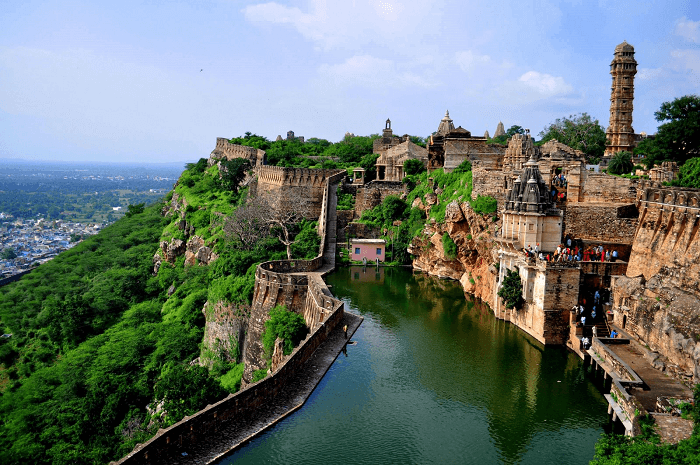
Built by: The Maurya dynasty Built-in: During the 7th Century AD Location: Chittorgarh, Rajasthan Ticket Price: For Indian visitors - INR 40, and for foreign visitors - INR 600 Timing: From 9:45 AM to 5:45 PM Best Time to Visit: From October - March OverviewThe historical fortification known as Chittorgarh Fort is situated in the Indian state of Rajasthan. The Maurya dynasty constructed the fort in the seventh century AD, and it is renowned for its beautiful architecture, extensive past, and cultural value. Over the ages, the fort was upgraded and enlarged by a number of dynasties, including the Rajputs, who built numerous temples, palaces, and gates to the complex. The fort is also well-known for its connections to a number of historical incidents, such as the renowned Jauhar, in which women and children gave their lives to save their honor during times of conflict. The Chittorgarh Fort is a well-known tourist attraction in Rajasthan and a UNESCO World Heritage Site today. The Kirti Stambh, the Vijay Stambh, and the Padmini Palace are just a few of the significant elements of the fort that highlight the rich cultural legacy and architectural prowess of the Rajputs. 40. Jantar Mantar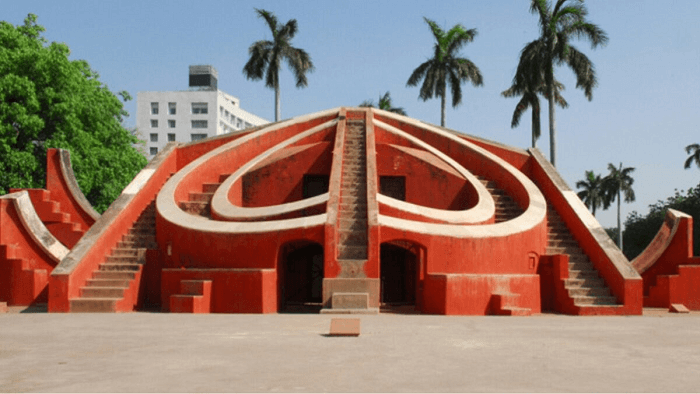
Built by: Jai Singh II Built-in: During the 18th Century AD Location: There are five Jantar Mantar in all over India, and they are in Delhi, Jaipur, Varanasi, Ujjain, and Mathura. Timing: From 6:00 AM to 6:00 PM Ticket Price: For Indian visitors - INR 15, and for foreign visitors - INR 200 (in Delhi) OverviewJantar Mantar is an astronomical observatory. It is a collection of 13 architectural astronomy devices that Maharaja Jai Singh II of Jaipur constructed in the early 18th century to measure the positions and motions of celestial objects. The instruments are composed of marble and stone and are quite accurate in construction. The Samrat Yantra, a massive sundial with an accuracy of roughly 2 seconds, is the most important piece of equipment. Other tools include the Misra Yantra, which calculates the shortest and longest days of the year, and the Jai Prakash Yantra, which calculates the locations of stars and planets. Today, Jantar Mantar is a well-liked tourist destination and a UNESCO World Heritage site. 41. Sultan Ghari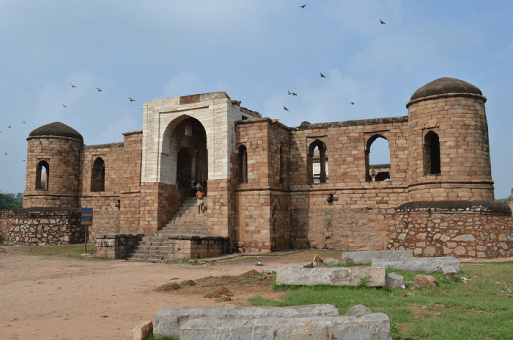
Built by: Sultan Iltutmish Built-in: During 1231 AD Location: Vasant Kunj, New Delhi Timing: From 6:00 AM to 6:00 PM Ticket Price: Free to all OverviewThe historical landmark Sultan Ghari, often spelled Sultan Garhi, is situated in Delhi, India. It is a mausoleum that Sultan Iltutmish, the third emperor of the Slave dynasty in India, constructed in the 13th century in honor of his son Nasiruddin Mahmud. The monument, which is renowned for its distinctive style and historical significance, is said to be the country's earliest Islamic mausoleum. It is a popular tourist site and is located in the Vasant Kunj district of Delhi. The tomb and its environs can be explored by guests who are interested in learning more about the local history and culture. Although there is no entry charge for seeing the monument, visitors must abide by the authorities' norms and regulations. 42. Taj Falaknuma Palace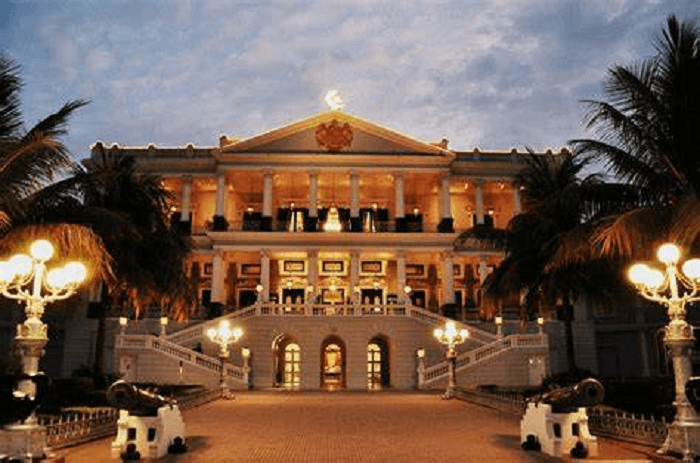
Built by: Nawab Vikar-ul-Umra Built-in: 1893 Location: Old Hyderabad, Hyderabad, Telangana Timing: Always Open Ticket Price: For Adults - INR 3100, and For Children - INR 2480 OverviewTaj Falaknuma Palace is a magnificent heritage hotel in Hyderabad, India. Nawab Vikar-ul-Umra, a nobleman and statesman of the Hyderabad State, erected the palace in 1893. Later, the Nizam of Hyderabad bought it, and it was used as a royal home for many years. The Taj Group renovated the palace and turned it into a hotel in 2010, and it is currently one of the most upscale and lavish hotels in India. The palace is a well-liked destination for affluent tourists and history lovers because of its magnificent architecture, lovely grounds, and opulent services. 43. Qutub Minar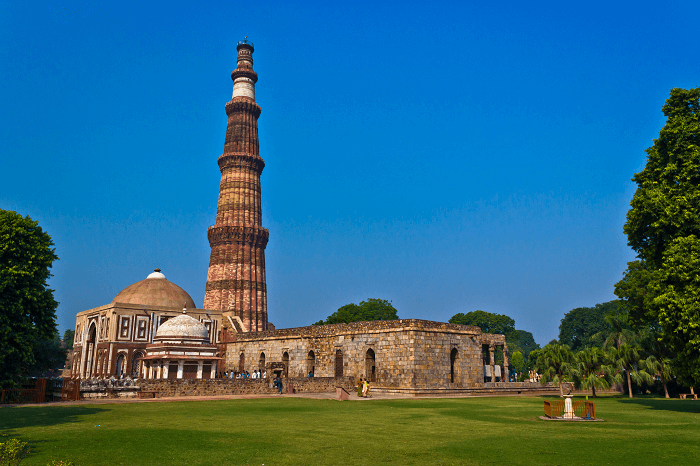
Built by: Qutb-ud-din Aibak Built-in: During the 13th century Location: Mehrauli, New Delhi Ticket Price: For Adults - INR 40, no need to buy tickets for below 15 years children. For Foreign visitors - INR 600 Additional Charges of INR 25 for still and Video Camera Timing: From 7:00 AM to 5:00 PM Best Time to Visit: At the Indian classical music festival, which typically takes place in November or December OverviewOne of India's most recognizable and well-liked tourist attractions is the towering Qutub Minar, which is situated in Delhi. The tower is 73 meters tall, composed of red sandstone, and has a base diameter of 14.3 meters and a summit diameter of 2.7 meters. Qutb-ud-din Aibak started building the tower as a triumphant monument to commemorate the Muslim conquest of Delhi in the early 13th century, and his successor Iltutmish finished it. The nearby Quwwat-ul-Islam Mosque used the Qutub Minar as its minaret. The five-story tower is decorated with ornate carvings and inscriptions, and a protruding balcony identifies each story. 44. Tughlaqabad Fort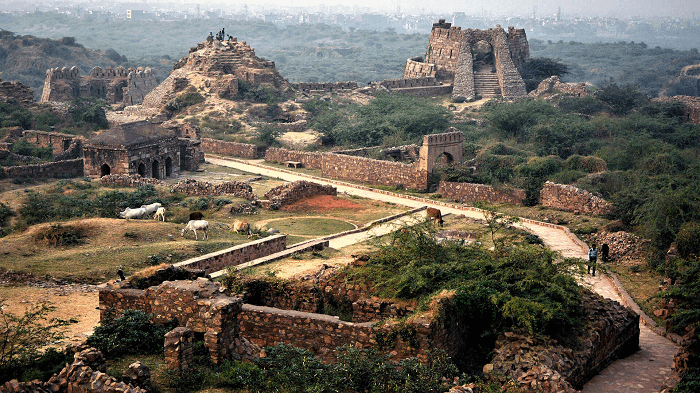
Built by: Ghiyas-ud-din Tughlaq Built-in: 1321 AD Location: Tughlaqabad, New Delhi Timing: From 6:00 AM to 7:00 PM Ticket Price: For Indian visitors - INR 20, and for foreign visitors - INR 250 OverviewTughlaqabad Fort, the city's most prominent structure, is a popular tourist attraction in Delhi. This fort on the Qutab-Badarpur Road is about 7 kilometers long and is quietly tucked away on a mountain. The fort is divided into three sections and has walls that are almost 15 meters high. The eastern part of the fort, which is a rectangular bastion surrounded by bastions in its heyday, is what visitors will find in the first section. The enclosure's other parts are separated from it by tall walls. The fort's westernmost portion is thought to contain the old palaces, while its southernmost section is home to a sizable reservoir. The reservoir comprises seven rainwater cisterns and is connected to Ghiyas-ud-Din's mausoleum by a land bridge, which is made possible by the bunds constructed between the hills. 45. Gumbaz Tipu Sultan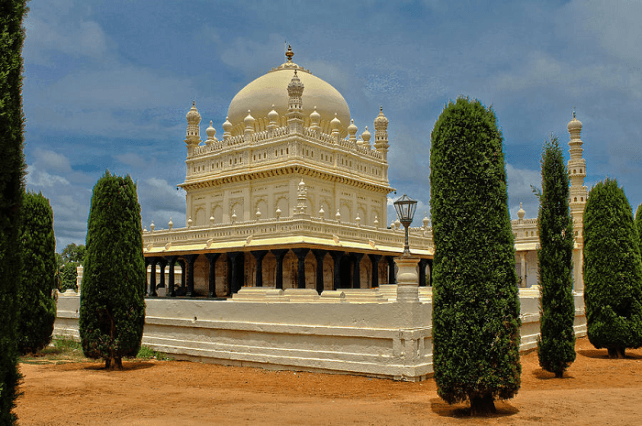
Built by: Tipu Sultan Built-in: 1782-84 AD Location: Srirangapatna, Karnataka Timing: From 10:00 AM to 5:00 PM Ticket Price: Free to all OverviewIn Srirangapatna, Karnataka, India, there is a historical site called Gumbaz or Gumbaz Mausoleum. It was created by Tipu Sultan in 1784 AD and served as the final resting place for him, his mother Fakhr-un-Nisa, his father, Hyder Ali, and other family members. The mausoleum is notable for its beautiful carvings, enormous dome, and Islamic-inspired architecture, which includes minarets. Additionally, it has unusual acoustical characteristics that cause an echo inside the dome. One of Karnataka's most significant monuments, The Gumbaz, is a well-liked tourist destination. 46. Udyagiri Caves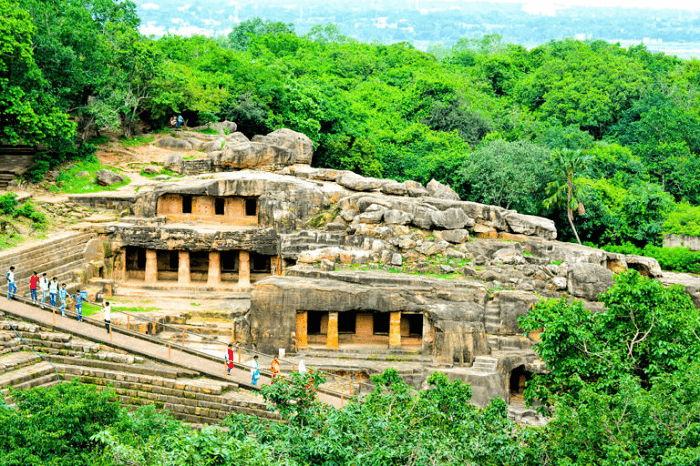
Built by: Chandragupta II Built-in: 375-413 AD Location: Vidisha, Madhya Pradesh Timing: From 9:00 AM to 6:00 PM Ticket Price: Free to all OverviewThe Udayagiri caves are a collection of 20 rock-cut caves in Madhya Pradesh's two tiny hills close to the Betwa River. These caves have some of the earliest buildings and cave art. These ancient caverns are maintained as protected monuments by the Archaeological Survey of India. Drawings of Lord Vishnu, Goddess Durga, and Lord Shiva can be found in the cave paintings. A stunning sculpture of Lord Vishnu as Varha, the man-boar, one of his incarnations, may also be found in one of these caverns. Numerous Gupta Dynasty inscriptions can be found in these caves as well. 47. Hazardauri Palace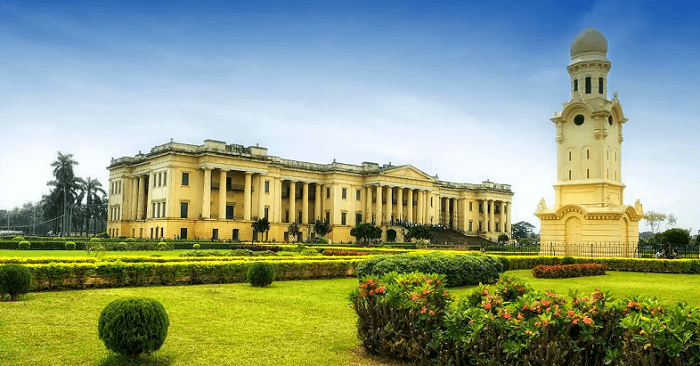
Built by: Nawab Nazim Humayun Jah Built-in: From 1829 to 1837 Location: Murshidabad, West Bengal Timing: From 6:00 AM to 6:00 PM Ticket Price: For Indian visitors - INR 20, and for foreign visitors - INR 250 OverviewThe palace is renowned for its distinctive architecture, a fusion of Indian and European designs. The palace is home to a museum with artifacts from the Nawabi period, including paintings, firearms, and other items. Although the palace doesn't have a thousand doors, the name "Hazarduari" means "a thousand doors" in Urdu. 48. Rajarani Temple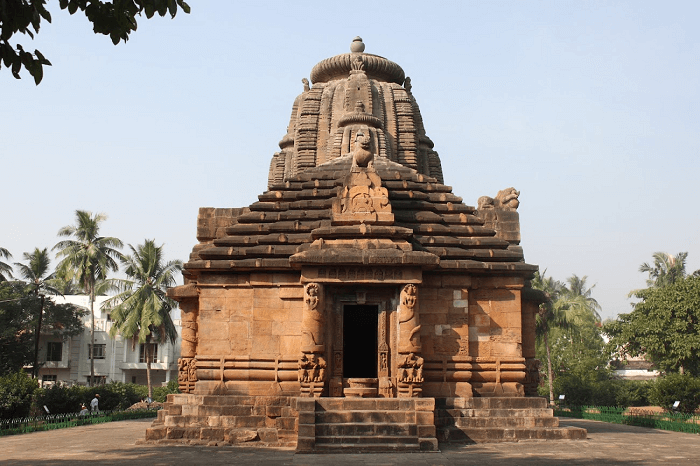
Built by: Somavashi Dynasty Built-in: 11th century Location: Bhubaneshwar, Odisha Timing: From 6:00 AM to 6:00 PM Ticket Price: For Indian visitors - INR 20, and for foreign visitors - INR 250 OverviewThe Rajarani Temple is a Hindu temple located in Bhubaneswar, the capital city of the Indian state of Odisha. It was constructed in the eleventh century and is well-known for its superb and detailed carvings, especially the friezes of the female dancers. It is not connected to any specific deity or religious sect, unlike other temples in the area, and is thought to have served the entire population. The temple is a well-liked destination for both tourists and believers and is open to visitors every day from sunrise to dusk. 49. Ranthambore Fort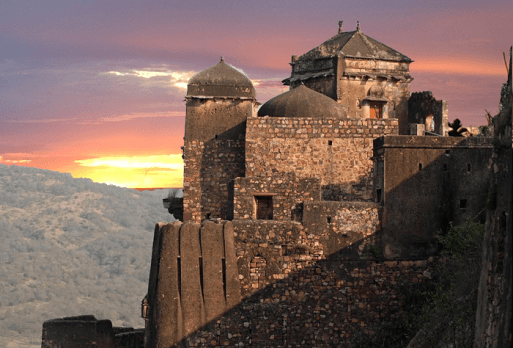
Built by: Chauhan dynasty Built-in: 10th century Location: Sawai Madhopur, Rajasthan Ticket Price: Free to all Timing: From 10:00 AM to 5:00 PM Best time to visit: In Winter (November to February) OverviewThe Rajasthani Hill Forts category includes Ranthambore Fort as one of its World Heritage Sites. Five temples made of red Karauli stone make up this fort. About 130 km separate this fort from Jaipur. Over time, many buildings of the Ranthambore Fort have become ruins. However, many worshipers still visit the temples in the fort. The fort's Hammir Kachaheri, Hammir Palace, Battis Khamba Chhatri, and Badal Mahal are just a few of its magnificent buildings. Navlakha Pol, Hathi Pol, Ganesh Pol, Andheri Pol, Delhi Pol, Satpol, and Suraj Pol are a few of the monument's well-known entrances. 50. Roopmati's Pavilion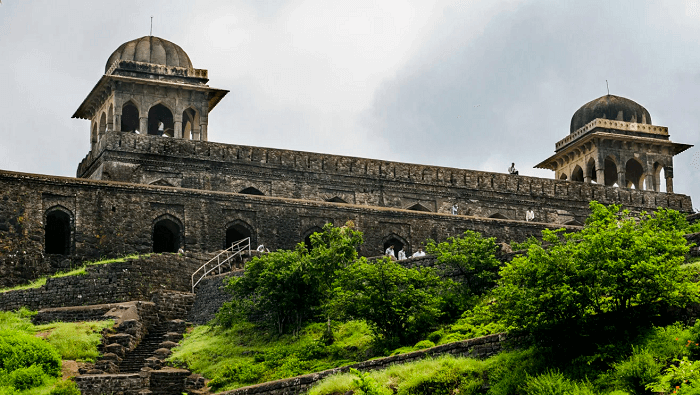
Built by: Baz Bahadur Built-in: 1555 to 1562 CE Location: Mandu, Madhya Pradesh Timing: From 6:00 AM to 6:30 PM Ticket Price: For Indian visitors - INR 20, and for foreign visitors - INR 250 OverviewAs a pleasure palace for his queen, Roopmati, Roopmati's Pavilion is thought to have been constructed under the rule of Baz Bahadur, the final independent Sultan of Mandu. The pavilion is well-known for its exquisite construction and breathtaking views of the surroundings, particularly the valley of the Narmada River. It is a well-liked tourist destination and a representation of Mandu's romantic past. Anyone traveling through the area must stop by the pavilion, which is open to visitors from sunrise to sunset.
Next TopicBGR Image
|
 For Videos Join Our Youtube Channel: Join Now
For Videos Join Our Youtube Channel: Join Now
Feedback
- Send your Feedback to [email protected]
Help Others, Please Share









